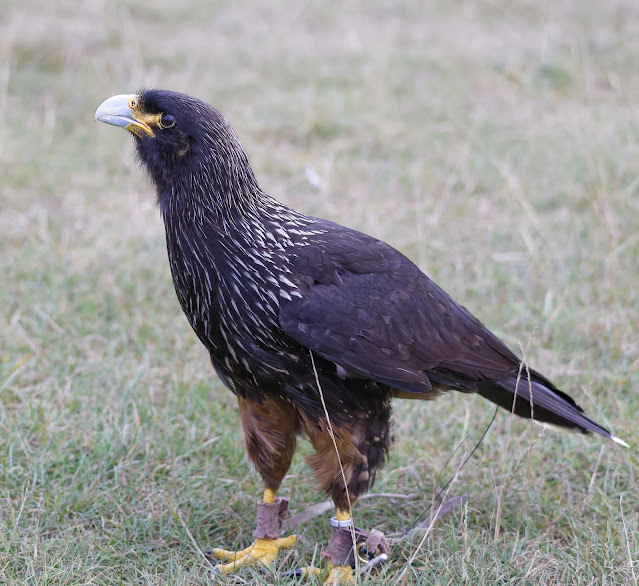Falconry at Belmont, end August 2024
Burrowing Owl
Athene cunicularia (Burrowing Owl) is a small, ground-dwelling owl native to the Americas, recognized for its long legs, bright yellow eyes, and distinctive white “eyebrows.” Unlike most owls, burrowing owls are active during the day, particularly at dawn and dusk, and they inhabit open landscapes such as grasslands, deserts, and agricultural areas. They often take over burrows made by mammals like prairie dogs for nesting and shelter. The global population of burrowing owls is estimated to be between 2 to 3 million birds.
Melanistic Barn Owl
Tyto alba (Melanistic Barn Owl) is a rare color morph of the common barn owl characterized by an unusually dark plumage caused by excess melanin. Unlike the typical white or light-colored barn owls, melanistic individuals have much darker feathers, often appearing entirely dark brown or black with the characteristic heart-shaped facial disk still visible. This morph is very rare, with only a few dozen individuals documented globally, in the wild. The exact number of melanistic barn owls is unknown, but they are considered extremely uncommon due to the rarity of the genetic mutation responsible for their colouration.
Harris Hawk
Parabuteo unicinctus (Harris's Hawk) is a medium-sized raptor native to the southwestern United States, Central America, and South America. It is known for its distinctive dark plumage with chestnut-red shoulders and thighs, white-tipped tail, and yellow legs. Harris's Hawks are unique among raptors for their social behavior; they often hunt in cooperative groups, allowing them to capture larger prey. They inhabit semi-arid environments such as deserts, scrublands, and open woodlands. The global population of Harris's Hawks is estimated to be around 250,000 to 500,000 individuals.
Turkey Vulture
Cathartes aura (Turkey Vulture) is a large bird of prey found throughout the Americas, from southern Canada to the southern tip of South America. It is easily identified by its dark brown to black plumage, bare red head, and broad wings with a distinctive two-toned pattern when viewed from below. Turkey Vultures are scavengers, feeding primarily on carrion, and they play an important role in the ecosystem by cleaning up dead animal matter. They have an excellent sense of smell, which helps them locate food from great distances. The global population of Turkey Vultures is estimated to be over 18 million individuals, and they are considered a species of least concern, with a stable population across most of their range.
Striated Caracara
Phalcoboenus australis (Striated Caracara), also known as the Johnny Rook, is a large, dark raptor native to the southernmost regions of South America, particularly the Falkland Islands and Tierra del Fuego. It is recognized by its predominantly black plumage, pale streaking on the head and neck, yellow-orange facial skin, and heavy, hooked bill. Unlike most raptors, Striated Caracaras are highly inquisitive and often display bold behavior around humans. They are scavengers, feeding on carrion, seabird eggs, small mammals, and invertebrates. The global population of Striated Caracaras is estimated to be between 1,000 to 2,500 individuals, making them one of the rarest raptors in the world. They are currently classified as Near Threatened due to their limited range, small population size, and threats from habitat loss and human activities.
Red backed Hawk
Buteo polyosoma (Red-backed Hawk), also known as the Variable Hawk, is a medium to large-sized raptor found in South America, ranging from the high Andes to the Patagonian plains. It is named for its reddish-brown or chestnut-colored back, though its plumage can vary significantly, giving rise to the name "Variable Hawk." The bird typically has a white or pale underbelly with dark streaks, and its tail may be barred or have a distinct white tip. Red-backed Hawks are solitary hunters, feeding primarily on small mammals, birds, and reptiles. The global population of the Red-backed Hawk is estimated to be around 100,000 to 1 million individuals.




























Comments
Post a Comment